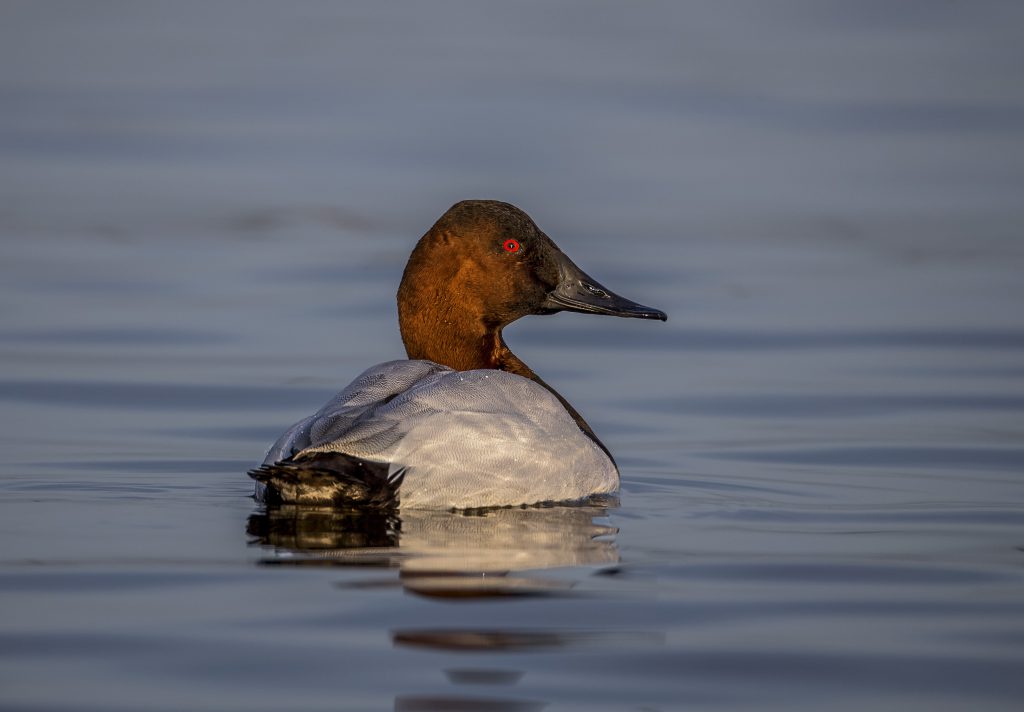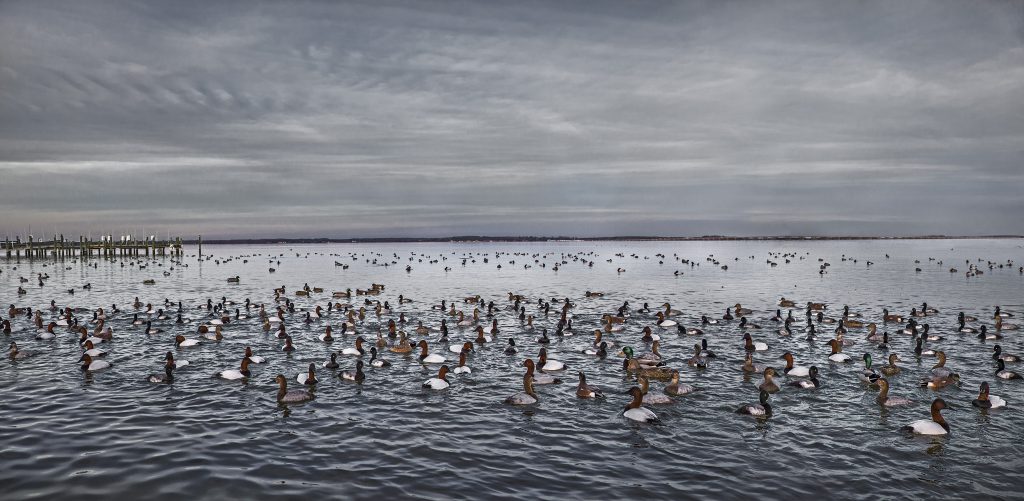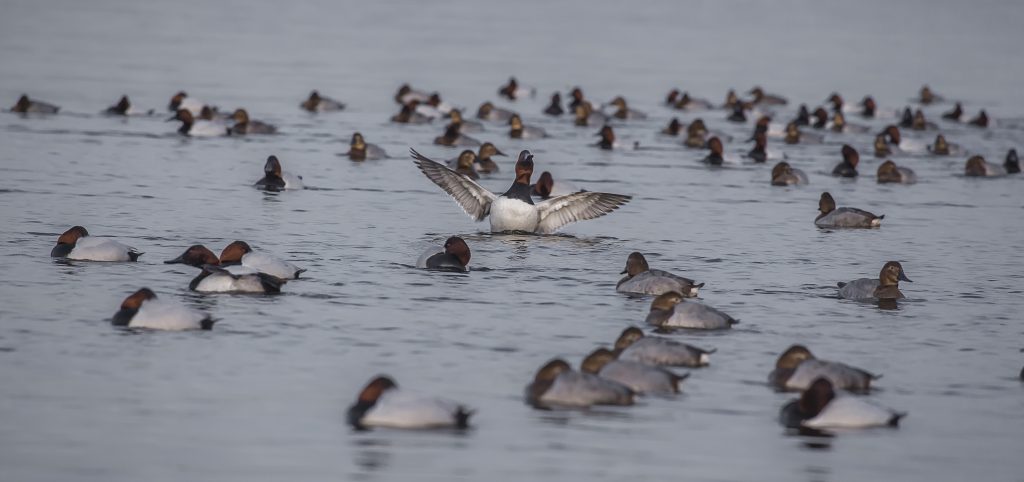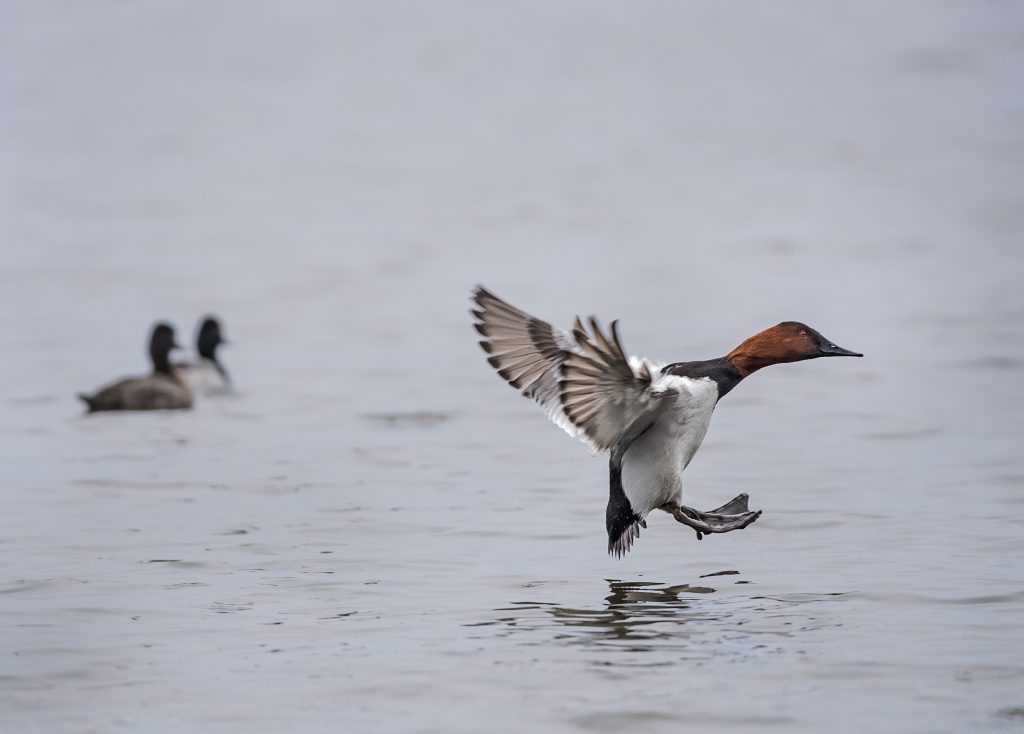The Canvasback Still Graces the Chesapeake
Science writer Cheryl Lyn Dybas and wildlife photographer Ilya Raskin visited Maryland DNR biologist Donald Webster along the Chesapeake in January 2020. Webster and his colleagues annually count canvasbacks and other wintering waterfowl on the Bay.
They came back,” says biologist Donald Webster. “This year.” His voice has a wistful note, wondering if the king of ducks, as the beautiful, crimson-headed canvasback is known, will return to rule Chesapeake Bay winter after winter.
Bundled in parka, gloves, and hat, Webster, Waterfowl Habitat Biologist for the Maryland Department of Natural Resources, raises his binoculars near a seawall at the confluence of the Chesapeake and the Choptank River in Cambridge, Maryland. The overlook is a mecca for wintering canvasbacks and other ducks. The Chesapeake Bay is the largest estuary in the U.S. and one of the most productive waterbodies in the world, attracting myriad waterfowl species.
“Canvasbacks, the ducks everyone comes to see, are usually here in force by Christmas, sometimes by Thanksgiving,” Webster says. “They stay through early to mid-March, then they’re gone, heading north to nesting grounds.”
On this January morning with calm winds and temperatures that hover just above freezing, the canvasbacks’ red heads stand out in winter-dark waters. Chesapeake skies fill with migrating ducks – canvasbacks, buffleheads, greater and lesser scaup, and many others – from December through March.
The ducks glide near the seawall, where photographers jostle for the quintessential shot of an iconic Chesapeake species. “This place is known as the ‘wall of shame,’” laughs Webster, “because it’s almost too easy to get great canvasback pictures here.”
The Bay is the Atlantic Coast’s most important waterfowl migration and wintering area. The Chesapeake and its 19 major tributaries offer refuge to 24 species of ducks as well as Canada geese, greater snow geese, and tundra swans.
“Long-term worsening of the Bay’s water quality, however, and loss of habitat, especially the underwater grasses so many of these birds depend on, have contributed to declines in wintering waterfowl populations,” says Webster.
Duck Feast to Famine
Through the Bay’s history, these grasses known as submerged aquatic vegetation (SAV) have foundered and flourished. Canvasbacks and other waterfowl species have done the same. As recently as 1950, half the continent’s population of canvasbacks – more than a quarter million – wintered in the Chesapeake, relying on aquatic grasses as favored food sources.
During Colonial times, as many as 1 million of the ducks may have spent wintertime on the bay. In the 19th century, their abundance and, to many, good taste made them a favored selection in many East Coast restaurants, says Matt Kneisley, regional director for the Northeast Atlantic Flyway at Delta Waterfowl, a waterfowl conservation and hunting organization.
“Canvasbacks were a favored quarry because their meat was considered the tastiest of all the ducks due to their consumption of wild celery,” writes Guy Baldassarre in the 2014 edition of Ducks, Geese and Swans of North America.
Adds Kneisley, “Large beds of wild celery once attracted thousands of the ducks to Susquehanna Flats and elsewhere on the upper Bay.” Then a decline in the Chesapeake’s water quality greatly reduced the amount of wild celery. Tropical Storm Agnes in 1972, which was devastating to SAV, was the final blow. “After the storm, wild celery was virtually impossible for canvasbacks to find,” says Kneisley.
The ducks switched their foraging efforts to small clams on the Chesapeake’s shallow bottom. A less nutritious diet of such shellfish as Baltic clams, scientists believe, may affect the ducks’ winter survival rates.
A Common Future
Half a century ago, 4 to 5 million ducks, geese, and swans spent time on Chesapeake Bay during the winter. Now, that number is less than 1 million, according to results from an annual midwinter waterfowl survey. The nationwide count has taken place every year since the 1950s.
Survey teams of biologists from the Maryland Department of Natural Resources and the U.S. Fish and Wildlife Service fly transects to make visual estimates of waterfowl along the Chesapeake and the nearby Atlantic coast. In 2023, the teams counted 632,200 ducks, geese and swans, slightly higher than the 627,000 birds observed in 2020, says Webster. (There was no survey in 2021 due to COVID-19 constraints, and DNR biologists consider the 2022 results an outlier for diving ducks due to late-arriving winter weather.) The best recent year was 2018, at 1,023,300.
Estimates of canvasbacks in 2023 were 57,800, and in 2020, 46,900. In 1955, by comparison, 225,450 canvasbacks were sighted. Nonetheless, says Webster, “this is still one of the best places on Earth to see waterfowl in winter, and as they migrate during fall and spring.”
Is Past Prologue?
Rising global temperatures may result in more frequent and severe droughts in the prairie pothole region, with devastating effects on breeding ducks.
Webster has witnessed the result in Chesapeake Bay.
“Decades ago,” he says, “the Chesapeake was full of wintering canvasbacks. But no more. I’d like to see the days again when their dark red heads stretched as far as you can see.”
Canvasbacks and the many other ducks that winter on the Bay have come a long way to get there, Webster says. “The least we can do is show them some hospitality by making sure their environment – including their wintering and breeding grounds – is healthy.”
Otherwise, he says, the Chesapeake’s waterfowl spectacle may vanish, the seawall along the Choptank indeed becoming a wall of shame as the last canvasback’s wing beats fade into silence.
dnr.maryland.gov/wildlife
Cheryl Lyn Dybas is a science writer based in Alexandria, Virginia. This article is an updated version of a story that previously ran in Oceanography magazine. Article appears in Vol. 26, No. 2 of the Maryland Natural Resource magazine.





 1-888-373-7888
1-888-373-7888 233733
233733